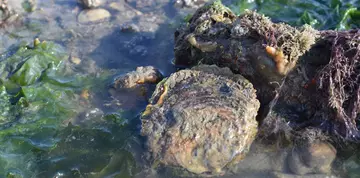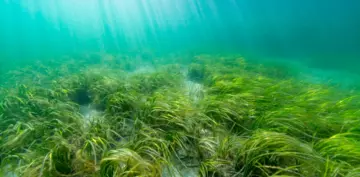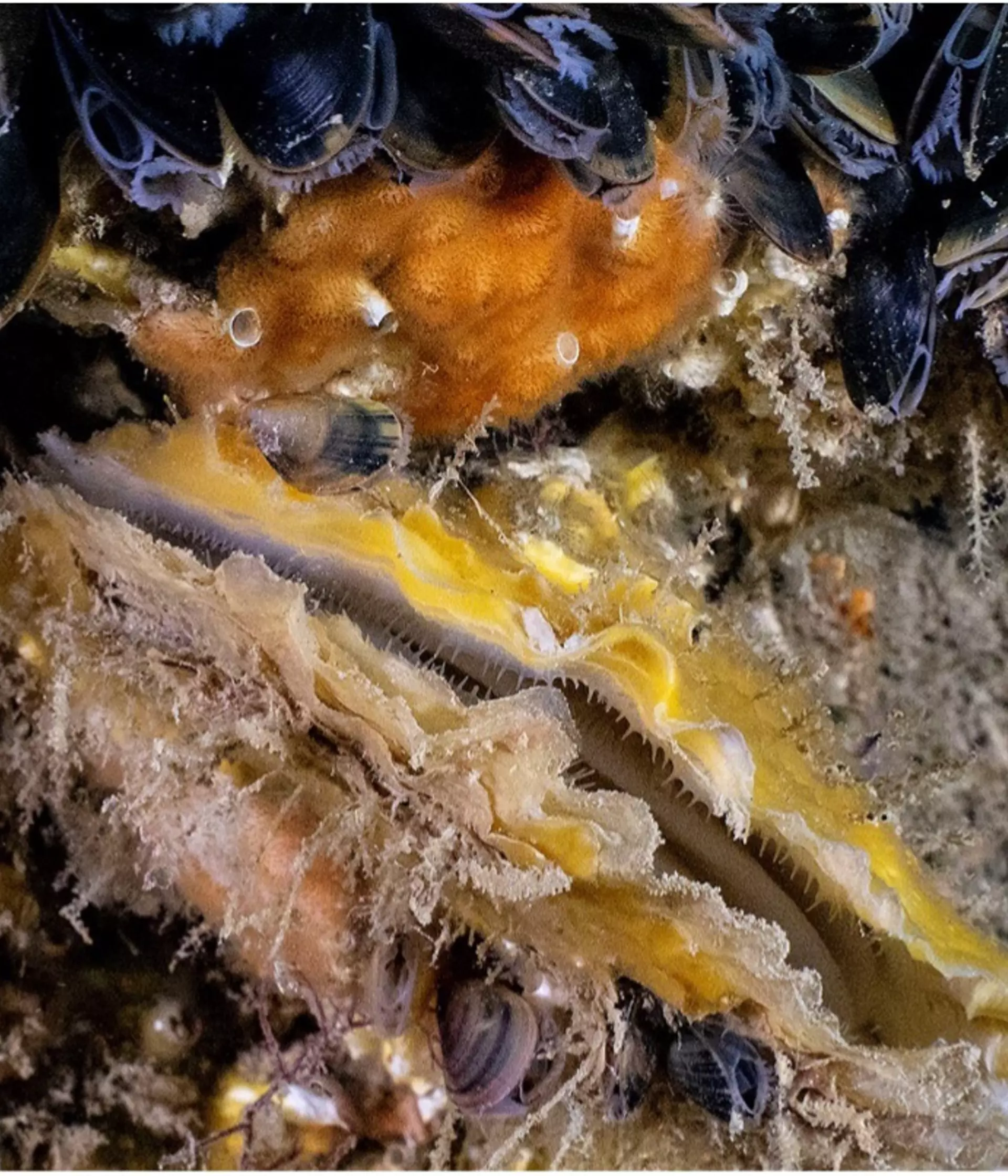
Alison Debney
Conservation Lead, Wetland Ecosystem Restoration
Marine habitats are essential to the health of our marine ecosystem, and hold environmental and social importance, providing valuable ecosystem services.
Over the past decade, the field of marine habitat restoration in Europe has grown significantly. This is a result of both our increased awareness of the extent of the degradation of marine habitats – including native oyster reefs, saltmarshes, seagrasses and kelp – and our knowledge of just how valuable these habitats are.
We are an official supporter of the United Nations Decade on Ecosystem Restoration, through the delivery of our marine habitat restoration projects. This UN decade (2021-2023) aims to prevent, halt and reverse the degradation of ecosystems on every continent and in every ocean.

Recovery of key habitats and species
European native oyster beds
Wild native oyster beds of Ostrea edulis are one of the most endangered marine habitats in Europe. In the UK wild native oyster populations have declined by over 95%. The loss of the wild native oysters is largely a result of historic overfishing with stock depletion being recorded as early as the first century AD.

Recovery has been significantly impaired because of habitat loss, smothering, contamination by synthetic compounds (particularly tributyltin (TBT) antifouling paints), introduction of microbial pathogens/parasites, including the protist Bonamia. The loss of native oysters has been so severe that natural replenishment of their native grounds is limited and is now unlikely to occur without our help.
Why are native oysters and native oyster beds important?
Oyster beds used to be an important structural and ecological component of Britain’s bays and estuaries and have fuelled waterside economies for centuries. The shellfish are known as ‘ecosystem engineers’ because they provide the foundation for entire ecosystems – filtering water and providing vital food and habitat for coastal wildlife.
Seagrass beds
Seagrass has been lost extensively across UK waters during the last 100 years, with recent research estimating that at least 44% of the UK’s seagrass has disappeared since 1936, with 39% of this happening in the last 30 years. This is due to pressures such as coastal development, pollution, and damage caused by fishing gear and leisure boat use. The loss of seagrass habitats has also meant that the benefits that people derive from these beds has been reduced.

Why are seagrass beds important?
Like the Native Oyster, seagrass is commonly known as a powerful ‘ecosystem engineer’, creating habitat for fish and other aquatic wildlife, connecting different natural spaces, and providing a range of ecological services. Seagrass beds store significant quantities of carbon and nitrogen, help to lessen the impacts of extreme weather and sea-level rise, improve water quality, and help stabilise the seabed.
Kelp forests
Kelp are large seaweeds that create undersea forests in rocky, coastal areas all around the world. In the UK we have extensive kelp forests, but like the rest of the world, our kelp forests are in decline, threatened by climate change, pollution, coastal development, damaging fishing practises and invasive species. Globally, kelp forests are declining faster than coral reefs and tropical rainforests.

Why are kelp important?
Just like terrestrial forests, kelp forests are important habitats, providing homes to many animals. A single kelp can be home to 80,000 organisms! Kelp provide valuable benefits to people such as nursery grounds to fisheries and coastal protection from waves, they also play an important role cycling nutrients through marine ecosystems.
Saltmarsh
Saltmarshes are a type of coastal wetland that appear as flat platforms of sediment covered with plants and interlaced with winding creeks. As the name suggests, saltmarshes are flooded by seawater as the tide comes in and exposed as the seawater drains away. The unique plant community that thrives here is salt-tolerant and divided into zones that are covered by the sea for different lengths of time.

Why are saltmarshes important?
Historically, saltmarsh was thought to be of low value and drained so that the land could be farmed. Thankfully, it is now recognised how important healthy saltmarsh is and how much we depend on it to reduce wave and tidal energy, protect against flooding, store carbon, and provide essential wildlife habitat for young fish to feed and grow in. To illustrate just how important saltmarsh is, in England alone, it is estimated to provide an incredible £1 billion of flood risk benefit. However, saltmarshes continue to be threatened, notably by climate change and sea level rise. In the UK, we have lost 85% of our saltmarsh habitat since the 1800’s, and work is underway to protect and restore this unique and critical habitat.
What are we doing?
Led by our passion for nature, scientific approach, and pioneering spirit, we lead conservation, shape agendas and influence change to protect and restore nature. We are working collaboratively to deliver and encourage the recovery and restoration of marine habitats. We have projects all over the UK including:
• Essex Native Oyster Restoration Initiative (ENORI)
• Native Oyster Network UK & Ireland
• Restoring the Thamescape
• Sussex Kelp Recovery Project
• Wild Oyster Project: Tyne & Wear, Conwy Bay and Firth of Clyde
ZSL is chair of the Essex Native Oyster Restoration Initiative (ENORI). The collaboration comprises oysterman, environmental conservation groups, academia and government. The shared vision is for the Essex estuaries to have self-sustaining populations of native oysters that provide ecosystem services, sustainable fisheries and increased biodiversity whilst recognising their cultural importance.
In 2013 the Blackwater, Crouch, Roach and Colne Estuaries Marine Conservation Zone was designated by the UK government with the conservation objective of recovering both native oyster beds (the habitat) and native oysters (the population) - this is the only protected area in the UK for native oyster beds. At 284km2, it is the largest protected area for native oysters in Europe.
We have two approaches to deliver the conservation objectives. We have established a voluntary no-take zone called the Blackwater Conservation Box. In this 200-hectare area, we are restoring the native oyster beds and we are doing this by adding cultch-old shell and gravels - to the seabed. This allows juvenile oyster spat to settle and grow into mature oysters. In addition, we are creating a ‘Mother Oyster’ sanctuary where we are translocating mature oysters who will spawn and settle on the improved seabed substrate.
In the remaining 282km squared, we are using adaptive management measures for a sustainable wild oyster fishery protected under byelaw. This has been developed in dialogue with industry, scientists and nature conservation authorities.
Project Information
Partners:
- ZSL
- The Nature Conservancy
- Native Oyster Network UK & Ireland
- University of Essex
- University of Edinburgh
- Natural England
- Cefas
- Environment Agency
- The Tollesbury & Mersea Native Oyster Fishery Company LTD
- Essex Wildlife Trust
- River Roach Oyster Company
- Blue Marine Foundation
- Colchester Oyster Fishery
- Kent and Essex Inshore Fisheries and Conservation Authority
Social Media:
Contact:
EssexNativeOyster@zsl.org
Find out more about the initiative on the ENORI website
The Native Oyster Network - UK and Ireland is a newly formed national network, that has been established in collaboration with ZSL and the University of Portsmouth. The network aims to facilitate an ecologically coherent and collaborative approach to native oyster restoration across the UK and Ireland. To do so, the network will facilitate effective communication and collaboration between the current native oyster restoration and research, and work to increase the awareness of the social and political worth of native oysters. Further to this, we hope to develop volunteering and opportunities for the general public to become engaged with the network.
At present, there are a number of established native oyster restoration projects across the UK and Ireland, located in Portsmouth, Essex, Scotland, Wales and Ireland. Each project has several different stakeholders involved, including local fishermen, NGOs, fisheries authorities, University researchers and students. We hope to see the number of restoration projects in the UK increase, with the support and knowledge shared through the new network. With the long-term goal of developing sustainable native oyster populations across the UK and Ireland.
Project Information
Partners:
- University of Portsmouth
- ZSL
Social Media:
Contact:
We want to restore coastal habitats across the Greater Thames Estuary to create cleaner water, sequester and store carbon, increase biodiversity and reconnect communities with their local blue spaces.
Healthy coastal habitats, like seagrass, saltmarsh, and oyster reefs, not only support healthy wildlife populations such as fish, but also provide us with valuable ecosystem services such as filtering and cleaning water, protecting our coastlines from wave energy, and capturing carbon. However, across the board, these coastal habitats are suffering, and we have seen staggering estimates of loss across the Greater Thames Estuary and the whole UK. With the loss and decline in condition of these habitats, we also lose the benefits they provide. At ZSL, we want to see the Thamescape restored to lush seagrass meadows, thriving oyster reefs and flourishing saltmarsh, that can support abundant wildlife and benefit people.
Given the high habitat potential of the area, ZSL started work at a pilot site in 2022 in the Medway and Swale Estuaries in the southern part of the Greater Thames Estuary in Kent. So far, the team have mapped and assessed the condition of almost 40 Hectares of an intertidal seagrass meadow, confirmed the presence of a residual population of native oysters, and began a small trial of seagrass seed collection in readiness for restoration trials in 2024. The next steps for us are to develop a habitat suitability model to help identify locations that will give us the best chance of seagrass restoration success. We will also continue to build up the evidence base of existing seagrass and native oysters in the Medway and Swale estuaries so that these can be safeguarded for the future and contribute towards the natural recovery of these habitats.
We are also working with coastal communities, stakeholders and conservation groups across the Thames to create a seascape-scale restoration plan. Together we want to achieve rapid large scale coastal habitat restoration, to protect communities and wildlife from the impacts of climate change.
Please follow us at @ZSLMarine and check out the ZSL Marine and Freshwater Facebook page to follow our restoration journey.
The Noltei Network was established by ZSL in 2022 to bring together practitioners, academics, and others working on the restoration of the intertidal seagrass species Zostera noltei in the UK and overseas in Europe. As restoration activities for Zostera noltei grow in the UK, the Network aims to increase knowledge sharing and facilitate learning and collaboration across projects.
For further information about the Noltei Network, please contact marineandfreshwater@zsl.org
There used to be a dense kelp habitat spanning 40km of the shoreline of Sussex on the south coast of England from Worthing to Pagham. Unfortunately, this was lost in the late 1980s. Efforts are being made to recover this habitat starting with the introduction of a bye law prohibiting seabed trawling over much of the historic kelp area.
The Sussex Kelp Recovery Project has a vision for the recovery of kelp and other essential fish habitats at scale in Sussex, to support a thriving and sustainable marine ecosystem that benefits nature, fisheries, coastal communities and our planet. Our purpose is to champion, study and facilitate the recovery of Sussex kelp and other essential fish habitats, through progressive, coherent and collaborative action.
The project is a collaboration between Sussex Wildlife Trust, Sussex Inshore Fisheries & Conservation Authority, Adur & Worthing Council, Blue Marine Foundation, Big Wave Productions, University of Brighton, University College London & ZSL. We are closely monitoring 25 sites across the region to understand how the seabed is responding to the introduction of the trawling ban.
The Wild Oysters project is aiming to restore Britain’s seas to health through the restoration of the native oyster! The project has a mission for UK seas to have a self-sustaining population of native oysters to help provide clean water, healthy fisheries, plentiful biodiversity and a re-ignite the love of the iconic native oyster.
The project is a national collaboration, led by the Zoological Society of London, Blue Marine Foundation and British Marine, working with the marine industry and local communities and organisations, to deliver restoration sites in England, Scotland and Wales. The Wild Oysters Project is aligned with the United Nations Sustainable Development goals and the UN Decade on Ecosystem Restoration
The Wild Oysters project is working with six marinas and ports around Britain and with the support of local delivery partners have established three restoration hubs across the UK. Restoration hubs are located in Conwy Bay (NW coast of Wales), Tyne and Wear (NE region of England) and Firth of Clyde (W Coast of Scotland) - so far, a total of 141 oyster nurseries have been installed!
Follow our project progress on Twitter.
An increasing evidence base illustrates the critical value of these coastal habitats individually. In this UN Decade on Ecosystem Restoration, the number and scale of restoration efforts is increasing and now is the time to reflect on the potential of the seascape to deliver for nature and people at a large scale. The role of habitats as part of a dynamic and resilient system is beginning to be understood. With the recently proposed EU Nature Restoration Law presenting a legally binding requirement to restore 20% of the EU marine territory, and with the Decade on Ecological Restoration and the Ocean Decade both underway, now is the time to reflect on what seascape connectivity could mean and what can be achieved in the longer term. Symposium sessions will focus on ecological connectivity, climate mitigation, resilience, restoration potential and benefits of restoration of threatened coastal habitats.
In November 2022 we hosted a two day symposium to provide a comprehensive review of the current state of science surrounding habitat connectivity in temperate coastal systems and provide a firm basis for discussion and networking relating to the policy and practical importance of this understanding. The symposium brought together a varied audience of scientists, policy makers, restoration practitioners and interested parties looking to provide evidence and delivery of seascape restoration.
The symposium was co-funded by the European Union, and opinions expressed however will be those of the author(s) only and do not necessarily reflect those of the European Union. Neither the European Union nor the granting authority CINEA can be held responsible for them.
